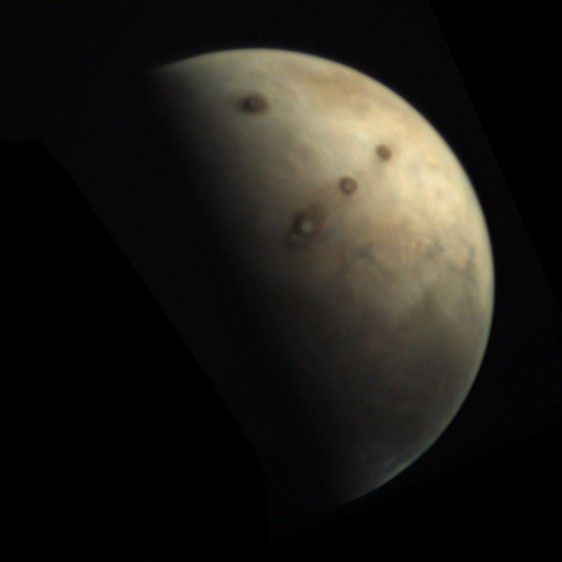Emily Lakdawalla • Oct 25, 2011
Mars Climate Sounder confirms a Martian weather prediction
One of the goals of scientific research is to understand something in the physical world well enough to make accurate predictions about the future. Weather is a classic prediction problem, and a good example of just how hard it is to describe complex systems well enough -- through equations or computer models -- to be able to predict the future.
One reason we study the atmospheres of other planets is because they represent other cases in which the same laws of physics produce very different results than what we observe on Earth. Improving our predictions of future weather on Venus, Mars, and Titan can help us understand our own weather better. So it's not only cool, it's important to report that the Mars Climate Sounder team has recently confirmed a prediction of a weather phenomenon on Mars that we haven't been able to observe before.

Here's the deal. Previous observations of Mars' atmosphere performed by Mars Global Surveyor, where the spacecraft transmitted radio signals through Mars' atmosphere to Earth, revealed that in Mars' tropics, a strong temperature inversion developed in the atmosphere overnight. What's a temperature inversion? Well, in the troposphere (the lowest layer of an atmosphere), the air usually gets cooler as you go higher in altitude, a phenomenon familiar to anyone who hikes mountains. This happens because it's the ground that absorbs most of the Sun's energy and reradiates it as heat, warming the air close to the ground. Occasionally, though, both on Earth and on Mars, the trend is opposite of what is expected, where there is warm air overlying cooler air in the troposphere, and that's called a temperature inversion.
Writing about this phenomenon, David Hinson and John Wilson suggested in 2004 that the inversion layer results from thermal tides in the Martian atmosphere, motions of cooler and warmer air that repeat on a daily basis. They used their model of thermal tides in Mars' atmosphere to predict a particular daily weather pattern.
Prominent nighttime clouds form within an elevated layer above Tharsis in our simulation. They descend steadily through the night, merge with the ground fog after 0400, diminish after 0700 in response to a combination of adiabatic warming and direct solar heating, and vanish by 1000. In this regard the simulation is qualitatively consistent with the properties of early morning clouds observed above Tharsis during the northern summer season.
It's a very specific prediction. They're saying that if you look at the region of Mars called Tharsis -- where there are high elevations associated with huge, ancient volcanoes -- you should see a high-elevation cloud forming overnight, a cloud that descends toward the surface and finally reaches it at about 4:00 a.m. Interestingly, it's not the cloud itself that's moving downward -- individual molecules of water aren't moving around much. What's moving is the temperature zone that favors the condensation of those water molecules into clouds. It's kind of like an ocean wave in that way -- the wave of cloud formation passes from high to low elevations every night.
Which is a neat prediction; the problem is, there wasn't any good way to verify it at the time. Hinson and Wilson explained in their paper that neither the laser altimeter or the thermal emission spectrometer on Mars Global Surveyor were able to detect whether atmospheric water was forming clouds overnight.
That changed when Mars Reconnaissance Orbiter arrived at Mars. Its Mars Climate Sounder was designed specifically to observe temperature, pressure, dust, water, and carbon dioxide content of Mars' atmosphere, day and night, observing continuously. Looking at the nighttime regions of the Martian tropics, Mars Climate Sounder did spot these clouds, and they behaved exactly as Hinson and Wilson had predicted, forming at high elevations at night and propagating as a wave to reach the ground by morning, where the rising Sun allows regular cameras to spot them around Mars' volcanoes.
How cool is it that we can predict Mars' weather? There's an additional coolness factor for me, because I live in a place where a similar temperature inversion forms nearly every day, as evening comes on, bringing with it a layer of clouds that typically prevents me from seeing the night sky from my home for months at a time. Here, too, the clouds descend in the morning, sometimes becoming, briefly, a fog that then dissipates. When I'm frustrated that the clouds associated with the Los Angeles basin's marine layer are preventing me from seeing the sky, I can console myself with the thought that residents of Tharsis would experience the same frustration!
Let’s Go Beyond The Horizon
Every success in space exploration is the result of the community of space enthusiasts, like you, who believe it is important. You can help usher in the next great era of space exploration with your gift today.
Donate Today

 Explore Worlds
Explore Worlds Find Life
Find Life Defend Earth
Defend Earth

